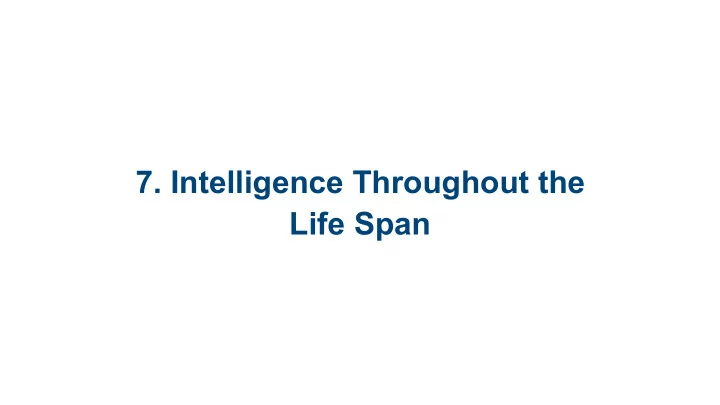

7. Intelligence Throughout the Life Span
7.1 Concepts of Intelligence and Creativity 7.2 Developmental Stability and Change 7.3 Heredity and Environment
7.4 Reaction Range 7.5 Intelligence Tests 7.6 Giftedness
7.1 Concepts of Intelligence and Creativity
Intelligence • Memory, understanding, communicating, planning, problem- solving
Intelligence • 3 components (Sternberg) • Processing/analytical • Contextual/practical • Experiential/creative • Fluid vs. crystallized (Cattell)
Intelligence categorized • Gardner’s 8 dimensions • Linguistic • Logical/mathematical • Spatial • Musical
• Bodily/kinesthetic • Interpersonal (between) • Intrapersonal (within) • Naturalistic
Creativity factors • Uses 3 types of intelligence • Ability to analyze • Ability to synthesize • Ability to make practical applications and changes • Needs divergent thinking to restructure problems or see multiple solutions
7.2 Developmental Stability and Change
Intelligence • Measured intelligence fairly stable and predictive • “ g factor” concept of generalized intelligence
Intelligence • Crystallized intelligence increases with age ➔ Intelligence stable ➔ Knowledge and ability to use knowledge changes
7.3 Heredity and Environment
Boosting intelligence? • Can a person’s intelligence be increased? • Genetic material is fixed • If environment/education improved ➔ Increase IQ scores ➔ Increase some abilities, not g factor
7.4 Reaction Range
Reaction range • Defines upper/lower limits of phenomenon • Intelligence reaction = range of IQ set by genes, influenced by environment • Explains IQ differences in twins raised apart
7.5 Intelligence Tests
Intelligence testing • Measures verbal and non-verbal abilities/ aptitude (functioning ability) • Aptitude is predictive of future ability and success
Intelligence testing • “Normed” = 100 is average with 15 pts per marking (standard deviation) • Bell-shaped curve
IQ categories • 130+ very superior (2%) • 116-129 superior (13.5%) • 101-115 above avg. (34%) • 85-99 below avg. (34%) • 70-84 borderline (13.5%) • 69- mentally defective (2%)
7.6 Giftedness
Giftedness • High IQ + 1 or more of these: • High achievement • Persistence on task • Creativity and/or artistry • Leadership ability
• Other possible traits: • Highly verbal/ imaginative • Prefer working alone • Emotional/social difficulty
Recommend
More recommend